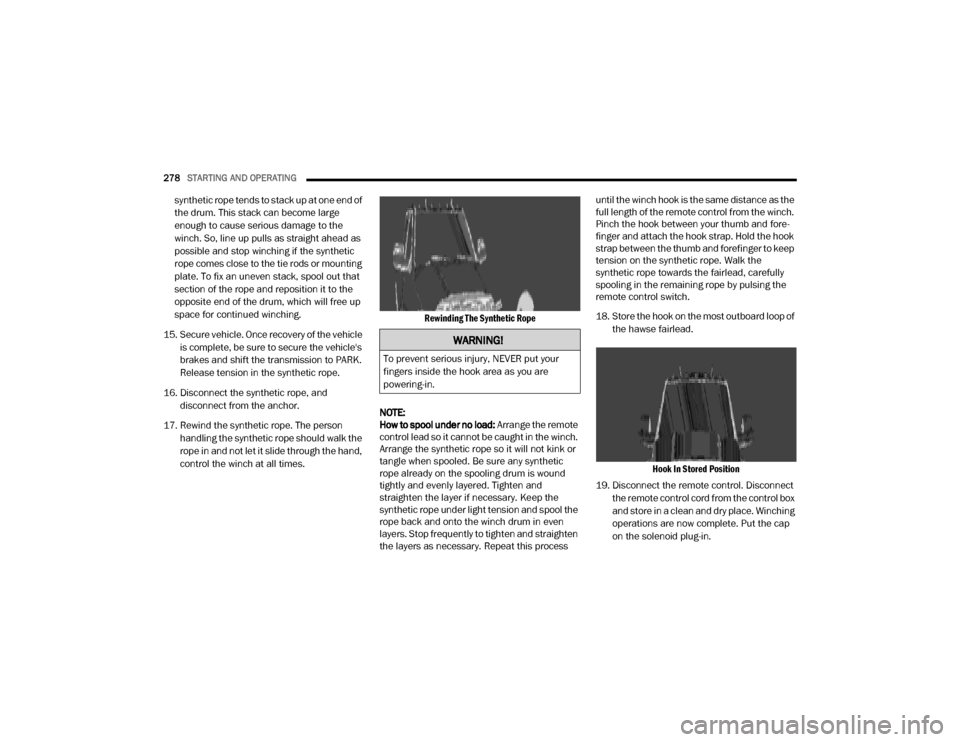warning light Ram 3500 2020 Manual PDF
[x] Cancel search | Manufacturer: RAM, Model Year: 2020, Model line: 3500, Model: Ram 3500 2020Pages: 568
Page 263 of 568

STARTING AND OPERATING261
SAFE OFF-ROAD DRIVING — POWER
WAGON ONLY
OFF-ROAD DRIVING TIPS AND VEHICLE
C
HARACTERISTICS
Your vehicle has excellent on and off-road
capabilities. These off-road capabilities will
allow you to explore those wilderness trails
where few travel, providing a source of exciting
and satisfying recreation. Before you venture
out, you should contact your local governmental
agency to determine the designated Off-Road
Vehicle (ORV) trails or recreation areas. You
should always tread lightly and only use
established roads, trails or ORV recreational
areas. The National Forest Service, Bureau of Land
Management, or local Department of Natural
Resources are a wealth of information and
usually have maps with marked trails.
Skid Plates And Underbody Protection
Steel skid plates protect the major driveline
components of the truck including the fuel tank,
transfer case and steering damper. In addition,
this vehicle is equipped with boxed cross
members and fore/aft rails. This additional
protection allows the vehicle to be utilized in
severe off-road situations that would be
considered impassable by a normal truck.
Ramp Travel Index (RTI)
The RTI is the distance, in inches, that you can
drive your vehicle with one wheel on a 20-degree
ramp without lifting any other wheel off the
ground. This distance up the ramp divided by the
wheelbase of the vehicle and multiplied by 1,000
is the RTI. This vehicle has an RTI of 429
(connected sway bar) or an RTI of 538
(disconnected sway bar), which means you can
articulate one front wheel 22 inches (56 cm) or
27.5 inches (70cm) in the air while the other
three wheels remain in contact with the ground.
Water Fording Characteristics
Water fording characteristic is the vehicle's ability
to cross a body of still water, where the
powertrain and drivetrain are safe from water
ingestion. This vehicle has high water fording
characteristics with the ability to cross a pool of
water, without stopping, 24 inches (60 cm) deep
at a maximum speed of 10 mph (16 km/h) and a
pool of water 30 inches (76 cm) deep at a
maximum speed of 5 mph (8 km/h), both with an
entrance ramp angle of 1.3 degrees.
Simultaneous Brake And Throttle
Operation
Many off-road driving conditions require the
simultaneous use of the brake and throttle (two
footed driving). When climbing rocks, logs, or
other stepped objects, using light brake
pressure with light throttle will keep the vehicle
from jerking or lurching. This technique is also
used when you need to stop and restart a
vehicle on a steep incline.
WARNING!
If the stabilizer/sway bar will not return to
On-Road mode, vehicle stability is reduced.
Do not attempt to drive the vehicle over
18 mph (29 km/h). Driving faster than
18 mph (29 km/h) may cause loss of control
of the vehicle, which could result in serious
injury or death. Contact your local service
center for assistance.
CAUTION!
The door sill height is 25 inches (63.5 cm).
Water may intrude into the interior of the
vehicle at greater depths.
5
20_DJD2_OM_EN_USC_t.book Page 261
Page 264 of 568

262STARTING AND OPERATING
The Basics Of Off-Road Driving
You will encounter many types of terrain driving
off-road. You should be familiar with the terrain
and area before proceeding. There are many
types of surface conditions: hard packed dirt,
gravel, rocks, grass, sand, mud, snow and ice.
Every surface has a different effect on your
vehicle's steering, handling and traction.
Controlling your vehicle is one of the keys to
successful off-road driving, so always keep a
firm grip on the steering wheel and maintain a
good driving posture. Avoid sudden
accelerations, turns or braking. In most cases
there are no road signs, posted speed limits or
signal lights. Therefore you will need to use your
own good judgment on what is safe and what
isn't. When on a trail you should always be
looking ahead for surface obstacles and
changes in terrain. The key is to plan your future
driving route while remembering what you are
currently driving over.
When To Use Low Range
When driving off-road, shift into 4WD LOW for
additional traction or to improve handling and
control on slippery or difficult terrain. Due to the
lower gearing, low range will allow the engine to
operate in a higher power range. This will allow
you to idle over obstacles and down hills, with
improved control and less effort. Also, use 4WD
LOW in rain, ice, snow, mud, and sand to get
heavy loads rolling, improve traction, or
whenever 4WD HIGH traction will not do the job.
DRIVING IN SNOW, MUD AND SAND
There is a drastic reduction in traction when
driving in snow, mud or sand. The vehicle will be
less responsive to steering, acceleration and
braking inputs. Therefore you should accelerate
slowly, leave greater stopping distances and
avoid abrupt vehicle maneuvers. You want to
keep a slow constant steady pace. The key is to
maintain the vehicle's momentum.
Snow – In heavy snow or for additional
control and traction at slower speeds, shift
the transmission to a low gear and shift the
transfer case to 4WD LOW if necessary. Do
not shift to a lower gear than necessary to
maintain headway. Over-revving the engine
can spin the wheels and traction will be lost.
If you start to slow to a stop, try turning your
steering wheel no more than a quarter turn
quickly back and forth, while still applying
throttle. This will allow the tires to get a fresh
"bite" and help maintain your momentum.
Mud – Deep mud creates a great deal of
suction around the tires and is very difficult to
get through. You should use 4WD LOW with a
gear low enough to maintain your momentum
without shifting. If you start to slow to a stop,
try turning your steering wheel no more than
a quarter turn quickly back and forth for addi -
tional traction. Mud holes pose an increased
threat of vehicle damage and getting stuck.
WARNING!
Always wear your seat belt and firmly tie down
cargo. Unsecured cargo can become
projectiles in an off-road situation.
CAUTION!
Never park your vehicle over dry grass or
other combustible materials. The heat from
your vehicle exhaust system could cause a
fire.
CAUTION!
On icy or slippery roads, do not downshift at
high engine RPMs or vehicle speeds because
engine braking may cause skidding and loss
of control.
20_DJD2_OM_EN_USC_t.book Page 262
Page 265 of 568

STARTING AND OPERATING263
They are normally full of debris from previous
vehicles getting stuck. As a good practice
before entering any mud hole, get out and
determine how deep it is, if there are any
hidden obstacles and if the vehicle can be
safely recovered if stuck.
Sand – Soft sand is very difficult to travel
through with full tire pressure. When crossing
soft sandy spots in a trail, maintain your
vehicle's momentum and do not stop. The
key to driving in soft sand is using the appro -
priate tire pressure, accelerating slowly,
avoiding abrupt maneuvers and maintaining
the vehicle's momentum. If you are going to
be driving on large soft sandy areas or dunes,
reduce your tire pressure to a minimum of
15 psi (103 kPa) to allow for a greater tire
surface area. Reduced tire pressure will dras -
tically improve your traction and handling,
while driving on the soft sand, but you must
return the tires to normal air pressure before
driving on pavement or other hard surfaces.
Be sure you have a way to air the tires back
up prior to reducing the pressure.
CROSSING OBSTACLES (ROCKS AND
O
THER HIGH POINTS)
While driving off road, you will encounter many
types of terrain. These varying types of terrain
bring different types of obstacles. Before
proceeding review the path ahead to determine
the correct approach and your ability to safely
recover the vehicle if something goes wrong.
Keeping a firm grip on the steering wheel, bring
the vehicle to a complete stop and then inch the
vehicle forward until it makes contact with the
object. Apply the throttle lightly while holding a
light brake pressure and ease the vehicle up
and over the object.
Using A Spotter
There are many times where it is hard to see the
obstacle or determine the correct path.
Determining the correct path can be extremely
difficult when you are confronting many
obstacles. In these cases have someone guide
you over, through, or around the obstacle. Have
the person stand a safe distance in front of you
where they can see the obstacle, watch your
tires and undercarriage, and guide you through.
Crossing Large Rocks
When approaching large rocks, choose a path
which ensures you drive over the largest with
your tires. This will lift your undercarriage over
the obstacle. The tread of the tire is tougher and
thicker than the side wall and is designed to
take the abuse. Always look ahead and make
every effort to cross the large rocks with your
tires.
CAUTION!
Reduced tire pressures may cause tire
unseating and total loss of air pressure. To
reduce the risk of tire unseating, while at a
reduced tire pressure, reduce your speed and
avoid sharp turns or abrupt maneuvers.
WARNING!
Crossing obstacles can cause abrupt steering
system loading which could cause you to
loose control of your vehicle.
CAUTION!
Never attempt to straddle a rock that is
large enough to strike your axles or under -
carriage.
Never attempt to drive over a rock which is
large enough to contact the door sills.
5
20_DJD2_OM_EN_USC_t.book Page 263
Page 266 of 568

264STARTING AND OPERATING
Crossing A Ravine, Gully, Ditch, Washout
Or Rut
When crossing a ravine, gully, ditch, washout or
a large rut, the angled approach is the key to
maintaining your vehicle's mobility. Approach
these obstacles at a 45-degree angle and let
each tire go through the obstacle
independently. You need to use caution when
crossing large obstacles with steep sides. Do
not attempt to cross any large obstacle with
steep sides at an angle great enough to put the
vehicle at risk of a rollover. If you get caught in
a rut, dig a small trench to the right or left at a
45-degree angle ahead of the front tires. Use
the removed dirt to fill the rut ahead of the
turnout you just created. You should now be
able to drive out following the trench you just
created at a 45-degree angle.
Crossing Logs
To cross a log, approach it at a slight angle
(approximately 10 to 15 degrees). This allows
one front tire to be on top of the log while the
other just starts to climb the log. While climbing
the log, modulate your brake and accelerator to
avoid spinning the log out from under your tires.
Then ease the vehicle off the log using your
brakes.
Getting High Centered
If you get hung up or high centered on an object,
get out of the vehicle and try to determine what
the vehicle is hung up on, where it is contacting
the underbody and what is the best direction to
recover the vehicle. Depending on what you are
in contact with, jack the vehicle up and place a
few rocks under the tires so the weight is off of
the high point when you let the vehicle down.
You can also try rocking the vehicle or winching
the vehicle off the object.
HILL CLIMBING
Hill climbing requires good judgment and a
good understanding of your abilities and your
vehicle's limitations. Hills can cause serious
problems. Some are just too steep to climb and
should not be attempted. You should always
feel confident with the vehicle and your abilities.
You should always climb hills straight up and
down. Never attempt to climb a hill on an angle.
Before Climbing A Steep Hill – As you
approach a hill consider its grade or steep -
ness. Determine if it is too steep. Look to see
what the traction is on the hill side trail. Is the
trail straight up and down? What is on top
and the other side? Are there ruts, rocks,
branches or other obstacles on the path?
Can you safely recover the vehicle if some -
thing goes wrong? If everything looks good
and you feel confident, then change trans-
mission into a lower gear, shift the transfer
WARNING!
There is an increased risk of rollover when
crossing an obstacle, at any angle, with steep
sides.
CAUTION!
Do not attempt to cross a log with a greater
diameter than the running ground clearance
or the vehicle will become high centered.
CAUTION!
Winching or rocking the vehicle off hard
objects increases the risk of underbody
damage.
20_DJD2_OM_EN_USC_t.book Page 264
Page 267 of 568

STARTING AND OPERATING265
case into 4WD LOW and proceed with
caution. You should use first gear and 4WD
LOW for very steep hills.
Driving Uphill – Once you have determined
your ability to proceed and have shifted into
the appropriate gear, line your vehicle up for
the straightest possible run. Accelerate with
an easy constant throttle and apply more
power as you start up the hill. Do not race
forward into a steep grade, the abrupt
change of grade could cause you to lose
control. If the front end begins to bounce,
ease off the throttle slightly to bring all four
tires back on the ground. As you approach
the crest of the hill ease off the throttle and
slowly proceed over the top. If the wheels
start to slip as you approach the crest of a
hill, ease off the accelerator and maintain
headway by turning the steering wheel no
more than a quarter turn quickly back and
forth. This will provide a fresh "bite" into the
surface and will usually provide enough trac -
tion to complete the climb. If you do not make
it to the top, place the vehicle in REVERSE
and back straight down the grade using
engine resistance along with the vehicle
brakes.
Driving Downhill – Before driving down a
steep hill you need to determine if it is too
steep for a safe descent. What is the surface
traction? Is the grade too steep to maintain a
slow controlled descent? Are there obsta -
cles? Is it a straight descent? Is there plenty
of distance at the base of the hill to regain
control if the vehicle descends too fast? If
you feel confident in your ability to proceed
then make sure you are in 4WD LOW with the
transmission in FIRST gear (manually select
FIRST gear on automatic transmissions) and
proceed with caution. Allow engine braking to
control the descent and apply your brakes if
necessary, but do not allow the tires to lock.
Driving Across An Incline – If at all possible
avoid driving across an incline. If it is neces -
sary, know your vehicle's abilities. Driving
across an incline places more weight on the
downhill wheels, which increases the possi -
bilities of a downhill slide or rollover. Make
sure the surface has good traction with firm
and stable soils. If possible transverse the
incline at an angle heading slightly up or
down.
WARNING!
Never attempt to climb a hill at an angle or
turn around on a steep grade. Driving across
an incline increases the risk of a roll over,
which may result in severe injury or death.
WARNING!
Do not descend a steep grade in NEUTRAL. Use
vehicle brakes in conjunction with engine
braking. Descending a grade too fast could
cause you to lose control and be seriously
injured or killed.
WARNING!
Driving across an incline increases the risk of
a rollover, which may result in severe injury.
5
20_DJD2_OM_EN_USC_t.book Page 265
Page 268 of 568

266STARTING AND OPERATING
If You Stall Or Begin To Lose Headway – If you
stall or begin to lose headway while climbing
a steep hill, allow your vehicle to come to a
stop and immediately apply the brake.
Restart the engine and shift into REVERSE.
Back slowly down the hill allowing the
compression braking of the engine and trans -
mission to help regulate your speed. If the
brakes are required to control vehicle speed,
apply them lightly and avoid locking or skid-
ding the tires.DRIVING THROUGH WATER
Extreme care should be taken crossing any type
of water. Water crossings should be avoided if
possible and only be attempted when
necessary, in a safe responsible manner. You
should only drive through areas which are
designated and approved. You should tread
lightly and avoid damage to the environment.
You should know your vehicle's abilities and be
able to recover it if something goes wrong. You
should never stop or shut a vehicle off when
crossing deep water unless you ingested water
into the engine air intake. If the engine stalls do
not attempt to restart it. Determine if it has
ingested water first. The key to any crossing is
low and slow. You want to use FIRST gear in
4WD LOW and proceed very slowly with a
constant slow speed (3-5 mph [5–8 km/h]
maximum) and light throttle. Keep the vehicle
moving; do not try to accelerate through the
crossing. After crossing any water higher than
the bottom of the axle differentials, you should
inspect all of the vehicle fluids for signs of water
ingestion.
Before You Cross Any Type Of Water – As you
approach any type of water you need to
determine if you can cross it safely and
responsibly. If necessary, get out and walk
through the water or probe it with a stick. You
need to be sure of its depth, approach angle,
current and bottom condition. Be careful of
murky or muddy waters, check for hidden
obstacles. Make sure you will not be
intruding on any wildlife and you can recover
the vehicle if necessary. The key to a safe
crossing is the water depth, current and
bottom conditions. On soft bottoms the
vehicle will sink in, effectively increasing the
water level on the vehicle. Be sure to
consider this when determining the depth
and the ability to safely cross.
WARNING!
If the engine stalls or you lose headway or
cannot make it to the top of a steep hill or
grade, never attempt to turn around. To do so
may result in tipping and rolling the vehicle,
which may result in severe injury. Always back
carefully straight down a hill in REVERSE.
Never back down a hill in NEUTRAL using only
the vehicle brakes. Never drive diagonally
across a hill, always drive straight up or down.
CAUTION!
Water ingestion into the axles, transmission,
transfer case, engine or vehicle interior can
occur if you drive too fast or through too deep
of water. Water can cause permanent
damage to engine, driveline or other vehicle
components and your brakes will be less
effective once wet and/or muddy.
20_DJD2_OM_EN_USC_t.book Page 266
Page 269 of 568

STARTING AND OPERATING267
Crossing Puddles, Pools, Flooded Areas Or
Other Standing Water – Puddles, pools,
flooded or other standing water areas
normally contain murky or muddy waters.
These water types normally contain hidden
obstacles and make it difficult to determine
an accurate water depth, approach angle,
and bottom condition. Murky or muddy water
holes are where you want to hook up tow
straps prior to entering. This makes for a
faster, cleaner and easier vehicle recovery. If
you are able to determine you can safely
cross, than proceed using the low and slow
method.
Crossing Ditches, Streams, Shallow Rivers Or
Other Flowing Water – Flowing water can be
extremely dangerous. Never attempt to cross
a fast running stream or river even in shallow
water. Fast moving water can easily push
your vehicle downstream sweeping it out of
control. Even in very shallow water, a high
current can still wash the dirt out from around your tires putting you and your vehicle
in jeopardy. There is still a high risk of
personal injury and vehicle damage with
slower water currents in depths greater than
the vehicle's running ground clearance. You
should never attempt to cross flowing water
which is deeper than the vehicle's running
ground clearance. Even the slowest current
can push the heaviest vehicle downstream
out of control if the water is deep enough to
push on the large surface area of the
vehicle's body. Before you proceed deter
-
mine the speed of the current, the water's
depth, approach angle, bottom condition and
if there are any obstacles, then cross at an
angle heading slightly upstream using the
low and slow technique.
AIRING DOWN FOR OFF-ROAD DRIVING
Running lower tire pressure off-road can improve
your ride comfort and vehicle traction. Reducing
the tire air pressure allows the tire to bulge
slightly, improving its surface area for better
flotation and ability to mold or form to the ground
contour. Different terrain, tires, and vehicles
require different tire pressure. Hard surfaces like
rock and heavier vehicles require higher
pressures than softer surfaces such as sand and
lighter vehicles. You will need to experiment to
determine what is right for your situation. It is
easier and faster to let air out than it is to replace
it. Start high and lower it as required. Remember
you must return the tires to normal air pressure
before driving on road or at highway conditions.
Be sure you have a way to return the tires to their
normal on road air pressure.
CAUTION!
Muddy waters can reduce the cooling system
effectiveness by depositing debris onto the
radiator.
WARNING!
Never drive through fast moving deep water. It
can push your vehicle downstream, sweeping
it out of control. This could put you and your
passengers at risk of injury or drowning.CAUTION!
Reduced tire pressure increases the risk of
tire damage and may cause tire unseating
with total loss of air pressure. To reduce the
risk of tire unseating, while at a reduced tire
pressure, drive at slower speeds and avoid
sharp turns or abrupt maneuvers.
5
20_DJD2_OM_EN_USC_t.book Page 267
Page 271 of 568

STARTING AND OPERATING269
30 feet (6 to 9 meters) between the vehicles
to allow for a safe recovery. If necessary join
two tow straps together using a 1.5 inch hard
wood dowel. This will keep the straps from
becoming knotted and is safer than using a
clevis pin if the strap breaks. Next have the
tow vehicle backup, leaving two to three feet
worth of slack in the strap. Then the tow
vehicle, using light throttle, should accelerate
tightening the strap providing the pulling
force needed to free the vehicle. The vehicle
being recovered should assist in the
recovery, at the time of the snap, by slowly
spinning the tires in the same direction as
the pulling vehicle. After the vehicle becomes
free, the driver of the previously stuck vehicle
should signal they are free and should hit
their brakes stopping both vehicles. The
driver of the pulling vehicle should let off the
throttle without using the brakes, once
signaled by the other driver. This sequence is
important to avoid having the recovered
vehicle hit the pulling vehicle.
Winching (Refer To “Winch Operation” For
Additional Information) – Winching is most
commonly used in the following situations:
there is no support vehicle available, a high
controlled force is required to recover the
vehicle, there is a high risk of environmental
or vehicle damage, or where nothing else
seems to work. A winch can deliver a high
pulling force with a great deal of control. It
allows you to walk the vehicle out of the situ -
ation in a slow controlled manner. This
control works well for avoiding further vehicle
damage. Once you decide it is time to use the
winch look for a good anchor point. It needs
to be strong enough to hold more than the vehicle's weight and provide a direction of
pull as straight as possible. Use block and
tackle if necessary to improve the angle of
pull or increase the winch's pulling force. If
the anchor point is a tree use a strap around
its base and hook the cable to the strap. If it
is another vehicle, then place that vehicle in
PARK and block the front tires. If you cannot
find an anchor point within reach try using
your spare tire by burying it. Once you have
determined an anchor point hook up the
cable, ensuring there are a least five wraps of
cable left on the drum, and place a floor mat
or something else over the strung out cable.
Placing something over the strung out cable
helps keep the cable on the ground if it
breaks. Next, place the vehicle in FIRST gear
and apply a very light throttle as you power
the winch in. Be careful not to allow slack in
the cable as you recover the vehicle. Do not
try to guide the cable into the drum. If it starts
to bunch up on one end, let it. You can
re-spool the cable afterwards. Never use a
winch cable as a tow strap and always stand
back while winching.
WARNING!
Never use tow straps with end hooks or link
two straps with a clevis pin. These heavy
metal objects could become projectiles if a
strap breaks, which could cause severe
injury. Never leave more than 2 to 3 feet
(0.60 to 1 meter) of slack in the strap. More
slack than this greatly increases the risk of
injury and vehicle damage. Always keep
everyone at least 30 feet (9 meters) away
from a strapping or winching situation.
5
20_DJD2_OM_EN_USC_t.book Page 269
Page 272 of 568

270STARTING AND OPERATING
AFTER DRIVING OFF-ROAD
Off-road operation puts more stress on your
vehicle than does most on-road driving. After
going off-road, it is always a good idea to check
for damage. That way you can get any problems
taken care of right away and have your vehicle
ready when you need it.
Completely inspect the underbody of your
vehicle. Check tires, body structure, steering,
suspension, and exhaust system for damage.
Inspect the radiator for mud and debris and
clean as required.
Check threaded fasteners for looseness,
particularly on the chassis, drivetrain compo -
nents, steering, and suspension. Retighten them, if required, and torque to the values
specified in the Service Manual.
Check for accumulations of plants or brush.
These things could be a fire hazard. They
might hide damage to fuel lines, brake hoses,
axle pinion seals, and propeller shafts.
After extended operation in mud, sand,
water, or similar dirty conditions, have the
radiator, fan, brake rotors, wheels, brake
linings, and axle yokes inspected and
cleaned as soon as possible.
If you experience unusual vibration after
driving in mud, slush or similar conditions,
check the wheels for impacted material.
Impacted material can cause a wheel imbal-
ance and freeing the wheels of it will correct
the situation.
LIMITED-SLIP DIFFERENTIAL
The limited-slip differential provides additional
traction on snow, ice, mud, sand and gravel,
particularly when there is a difference between
the traction characteristics of the surface under
the right and left rear wheels. During normal
driving and cornering, the limited-slip unit
performs similarly to a conventional differential.
On slippery surfaces, however, the differential
delivers more of the driving effort to the rear
wheel having the better traction.
The limited-slip differential is especially helpful
during slippery driving conditions. With both rear
wheels on a slippery surface, a slight application
of the accelerator will supply maximum traction.
When starting with only one rear wheel on an
excessively slippery surface, slight momentary
application of the parking brake may be
necessary to gain maximum traction.
WARNING!
Winch cables are under high tension when in
use and can become a projectile if they fail.
Never stand over or straddle the winch cable.
Never jerk or overload the winch cable. Never
stand in front of the vehicle while winching.
Failure to follow these instructions can result
in serious or fatal injury.
WARNING!
Abrasive material in any part of the brakes
may cause excessive wear or unpredictable
braking. You might not have full braking
power when you need it to prevent a collision.
If you have been operating your vehicle in
dirty conditions, get your brakes checked and
cleaned as necessary.
WARNING!
On vehicles equipped with a limited-slip
differential never run the engine with one rear
wheel off the ground since the vehicle may
drive through the rear wheel remaining on the
ground. You could lose control of the vehicle.
20_DJD2_OM_EN_USC_t.book Page 270
Page 280 of 568

278STARTING AND OPERATING
synthetic rope tends to stack up at one end of
the drum. This stack can become large
enough to cause serious damage to the
winch. So, line up pulls as straight ahead as
possible and stop winching if the synthetic
rope comes close to the tie rods or mounting
plate. To fix an uneven stack, spool out that
section of the rope and reposition it to the
opposite end of the drum, which will free up
space for continued winching.
15. Secure vehicle. Once recovery of the vehicle is complete, be sure to secure the vehicle's
brakes and shift the transmission to PARK.
Release tension in the synthetic rope.
16. Disconnect the synthetic rope, and disconnect from the anchor.
17. Rewind the synthetic rope. The person handling the synthetic rope should walk the
rope in and not let it slide through the hand,
control the winch at all times.
Rewinding The Synthetic Rope
NOTE:
How to spool under no load: Arrange the remote
control lead so it cannot be caught in the winch.
Arrange the synthetic rope so it will not kink or
tangle when spooled. Be sure any synthetic
rope already on the spooling drum is wound
tightly and evenly layered. Tighten and
straighten the layer if necessary. Keep the
synthetic rope under light tension and spool the
rope back and onto the winch drum in even
layers. Stop frequently to tighten and straighten
the layers as necessary. Repeat this process until the winch hook is the same distance as the
full length of the remote control from the winch.
Pinch the hook between your thumb and fore
-
finger and attach the hook strap. Hold the hook
strap between the thumb and forefinger to keep
tension on the synthetic rope. Walk the
synthetic rope towards the fairlead, carefully
spooling in the remaining rope by pulsing the
remote control switch.
18. Store the hook on the most outboard loop of
the hawse fairlead.
Hook In Stored Position
19. Disconnect the remote control. Disconnect the remote control cord from the control box
and store in a clean and dry place. Winching
operations are now complete. Put the cap
on the solenoid plug-in.
WARNING!
To prevent serious injury, NEVER put your
fingers inside the hook area as you are
powering-in.
20_DJD2_OM_EN_USC_t.book Page 278